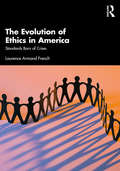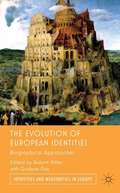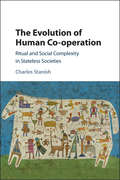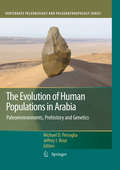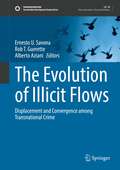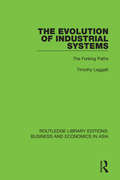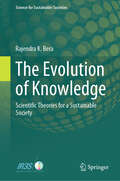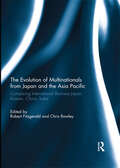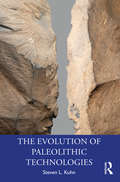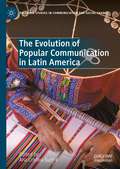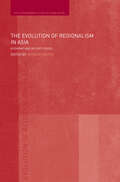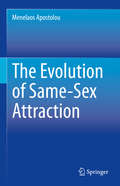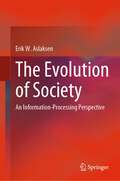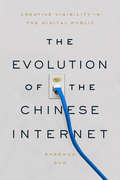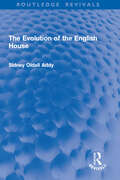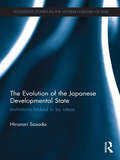- Table View
- List View
The Evolution of English Language Learners in Japan: Crossing Japan, the West, and South East Asia (Routledge Research in Language Education)
by Yoko KobayashiThis book seeks a better understanding of the sociocultural and ideological factors that influence English study in Japan and study-abroad contexts such as university-bound high schools, female-dominant English classes at college, ESL schools in Canada, and private or university-affiliated ESL programs in Singapore and Malaysia. The discussion is based not only on data garnered from Japanese EFL learners and Japanese/overseas educators but also on official English language policies and commercial magazine discourses about English study for Japanese people. The book addresses seemingly incompatible themes that are either entrenched in or beyond Japan’s EFL context such as: Japan’s decades-long poorly-performing English education vs. its equally long-lived status as an economic power; Japanese English learners’ preference for native English speakers/norms in at-home Japanese EFL contexts vs. their friendship with other Asian students in western study-abroad contexts; Japanese female students’ dream of using English to further their careers vs. Japanese working women’s English study for self-enrichment; Japanese society’s obsession with globalization through English study vs. the Japanese economy sustained by monolingual Japanese businessmen; Japanese business magazines’ frequent cover issues on global business English study vs. Japanese working women’s magazines’ less frequent and markedly feminized discourses about English study.
The Evolution of Ethics in America: Standards Born of Crises
by Laurence Armand FrenchIn this book, Laurence Armand French frames the emergence of medical, clinical, and legal ethical standards within the long history of institutional and systemic racial and gender biases in the United States. He explores the role that White privilege and elitism play in justifying long-held discriminatory practices ranging from the eugenics crusade a century ago to the #MeToo and Black Lives Matter (BLM) movements of today. This book identifies and analyzes events highlighting systemic racism in the United States and explores how these events were exacerbated during the presidency of Donald J. Trump. The evolution of ethical standards in the United States is a reaction to long-held practices that discriminate against certain classes of people based on gender, age, and race and ethnicity. The White supremacist worldview contributed to systemic biases that directly affect people of color as well as women, and those biases, in turn, are inherent components of the social structure of economic, academic, and judicial institutions. This process impacts both procedural and social justice, the very foundation of ethical standards of which our Constitution is based. This work attempts to unravel the social and psychological aspects of human behavior contributing to this phenomenon. This concise yet comprehensive book is a valuable resource to a broad audience, including students of criminal justice, as well as scholars, researchers, and professionals in both the social and physical sciences.
The Evolution of European Identities
by Robert Miller Graham DayThe 'European project' is in a state of perpetual crisis in which the root cause is a lack of identification by ordinary citizens with Europe and European institutions. The Evolution of European Identities employs state of the art analysis of in-depth interviews by renowned practitioners to give a unique 'bottoms up' perspective on the development (or its lack) of a sense of 'European mental space'. Linking conceptual findings with case studies, the book provides unique insights into groups that have been especially sensitized by their life experiences to question what it means to be European in the twenty-first century. The groups explored in this book include: adults who experienced European education exchanges when young; transnational workers; civil society organization activists; persons involved in cross-border intimate relationships; farmers who are subject to European markets, regulations and subsidies; and migrants into 'fortress Europe'.
The Evolution of Exudativory in Primates
by Anne M. Burrows Leanne T. NashThis volume covers aspects of primate exudativory, one of the least common dietary niches among primates. While all primates are generally omnivorous animals, most species, depending on body size, acquire the majority of their energy from fruit, leaves or insects and the majority of their protein from insects or leaves. However, some specialize their caloric intake around the acquisition, processing, and break-down of exudates, the saps and gums produced by trees in response to mechanical or insect damage. Compared to leaves, insects or fruits, these compounds have a unique combination of challenges to the dentition for acquisition and processing and to the gut for digestion. This volume brings together our current knowledge on the morphological, physiological, and evolutionary aspects of being a primate exudativore and to fit these into an evolutionary context. Included in this work are comparisons to marsupial exudates-feeders and the chemical characteristics of exudates.
The Evolution of Human Co-operation: Ritual and Social Complexity in Stateless Societies
by Charles StanishHow do people living in small groups without money, markets, police and rigid social classes develop norms of economic and social cooperation that are sustainable over time? This book addresses this fundamental question and explains the origin, structure and spread of stateless societies. Using insights from game theory, ethnography and archaeology, Stanish shows how ritual - broadly defined - is the key. Ritual practices encode elaborate rules of behavior and are ingenious mechanisms of organizing society in the absence of coercive states. As well as asking why and how people choose to co-operate, Stanish also provides the theoretical framework to understand this collective action problem. He goes on to highlight the evolution of cooperation with ethnographic and archaeological data from around of the world. Merging evolutionary game theory concepts with cultural evolutionary theory, this book will appeal to those seeking a transdisciplinary approach to one of the greatest problems in human evolution.
The Evolution of Human Populations in Arabia
by Jeffrey I. Rose Michael D. PetragliaThe contemporary deserts of Arabia form some of the most dramatic arid landscapes in the world; yet, during many times in the past, the region was well-watered, containing evidence for rivers and lakes. Climatic fluctuations through time must have had a profound effect on human population that lived and passed through the region. In this book, paleoenvironmental specialists, archaeologists and geneticists are brought together to provide a comprehensive account of the evolution of human populations in Arabia. A wide range of topics are explored in this book, including environmental change and its impact on human populations, the movement and dispersal of populations through the region, and the origin and spread of food producing economies. New theories and interpretations are presented which provide new insights into the evolution of human populations in a key region of the world.
The Evolution of Illicit Flows: Displacement and Convergence among Transnational Crime (Sustainable Development Goals Series)
by Ernesto U. Savona Alberto Aziani Rob T. GueretteThis book focuses on the displacement and convergence of transnational crimes in North Africa and in the area of the Mediterranean Sea, providing empirical analysis of human smuggling and of drug trafficking. It discusses the displacement of crime due to the exploitation of asymmetries in legislation, law enforcement, and other vulnerabilities. Using an innovative multimethodology, this volume describes the evolution of illicit flows related to human smuggling and trafficking of illicit goods. This approach helps to provide critical information such as traffickers’ modi operandi, most exploited paths, and trafficked goods, that would not be achievable through more traditional methods. The Evolution of Illicit Flows will be a valuable resource for scholars and researchers of criminology and migration studies, as well as for policymakers and law enforcement working in transnational crimes and trafficking.
The Evolution of Industrial Systems: The Forking Paths (Routledge Library Editions: Business and Economics in Asia #12)
by Timothy LeggattThis book, first published in 1985, tackles simultaneously three major questions about the course of industrial evolution: what are the features of the industrial systems that have developed outside Western capitalism? What are the salient evolutionary developments now occurring in all advanced capitalist systems? What light can social theory throw upon the evolution of industrial systems thus far and in the future? In answering these questions the author provides an exposition of how the Soviet system works and how the Japanese system developed; a critical analysis of three issues of major contemporary concern – the control of giant corporations, the impact of automation, and the shift to service employment; and a commentary on the theories of classical and contemporary social thinkers. Concluding with his own conceptualisation of the determinants of industrial evolution, the author also offers his own evaluation of the needs of the advanced industrial societies.
The Evolution of Knowledge: Scientific Theories for a Sustainable Society (Science for Sustainable Societies)
by Rajendra K. BeraThis book emphasizes the rising need for people to have a basic understanding of science and technology and the emphatic role they can play in shaping the AI-driven future, especially in terms of creating sustainable societies with growing job opportunities. This book highlights why a smoothly functioning society will require, but does not yet possess in critical numbers, policymakers, senior managers, government officials, and those entering the high-end of the AI-driven job market who have a shared vision and a shared understanding of how science shapes the future of sustainable societies.This book makes the case that the destiny of Homo sapiens is not just about evolutionary biology but increasingly about evolutionary knowledge. This book describes the web of knowledge where scientific theories appear as intellectual constructs, which lead to new knowledge that open opportunities for gainful human employment for the well-educated while eliminating jobsfor the less-educated by advancing AI in a predator–prey adversarial model (the logistic map), thus raising livelihood concerns across wide swathes of human population.This inevitably leads to the question, “How should intellectual property rights, especially patents, be granted and protected when AI becomes advanced enough to invent without human intervention?” To answer this question, lawmakers, policymakers, managers, government officials, judiciary, enforcement agencies, etc., must have sufficient knowledge of how scientific theories impact modern society. After reading this book, the reader will be able to find answers to the following questions:• How do scientific theories impact modern society?• What is the intellectual base on which science and technology policies are founded?• Why do individuals across a population need to possess scientific knowledge?• What are the rising concerns of peoplein finding sustainable employment in an AI-driven world?• What is the compelling need to understand the role of patentable inventions in a world where intellectual property is wealth?
The Evolution of Multinationals from Japan and the Asia Pacific: Comparing International Business Japan, Korean, China, India
by Robert Fitzgerald and Chris RowleyThe rise of the Japanese multinational company (JMNC) marked, from the 1980s onwards, an historic change in the structure and in the dynamics of the international economy. For the first time, businesses from a non-Western nation established a competitive global presence, and they did so by bringing their advanced products and management systems to the developed economies of Europe and North America. In the last 30 years, our interpretations of JMNCs have undergone a series of revisions. Korean firms followed JMNCs in the 1990s and the Chinese likewise in the 2000s. A seeming decline in JMNC competitiveness and developments in the structure of the international economy challenged a business model of parental company direction, control and capabilities. Both trends asked questions about how Japanese subsidiaries should operate in global production chains increasingly reliant on contracting out and off-shoring, and how JMNCs might engage more in strategic cooperation and empower subsidiary decision-making. The contributors to this volume consider a wide range of relevant issues: they demonstrate the long-term evolution of JMNCs; they compare the experience of JMNCs with firms from the other two major Asia Pacific economies, Korea and China; they evaluate the applicability of established foreign direct investment (FDI) theory to MNCs from Japan and the Asia Pacific; and they reflect on the internal organization of JMNCs at the global, national and subnational level. This book was originally published as a special issue of Asia Pacific Business Review.
The Evolution of Paleolithic Technologies (Routledge Studies in Archaeology)
by Steven L. KuhnThe Evolution of Paleolithic Technologies provides a novel perspective on long-term trajectories of evolutionary change in Paleolithic tools and tool-makers. Members of the human lineage have been producing stone tools for more than 3 million years. These artefacts provide key evidence for important evolutionary developments in hominin behaviour and cognition. Avoiding conventional approaches based on progressive stages of development, this book instead examines global trends in six separate dimensions of technological behaviour between 2.6 million and 10,000 years ago. Combining these independent trends results in both a broader and a more finely punctuated perspective on key intervals of change in hominin behaviour. To draw this picture together, the concluding section explores behavioural, cognitive, and demographic implications of developments in material culture and technological procedures at seven key intervals during the Pleistocene. Researchers interested in Paleolithic archaeology will find this book invaluable. It will also be of interest to archaeologists researching stone tool technology and to students of human evolution and behavioural change in prehistory.
The Evolution of Policing: Worldwide Innovations and Insights (International Police Executive Symposium Co-Publications)
by Dilip K. Das Aiedeo Mintie Das Melchor C. de GuzmanDrawn from recent proceedings of the International Police Executive Symposium (IPES), this volume explores major policing initiatives and evolutions across the globe and presents practical insights on how police are retooling their profession. The book discusses the trends in evolving police roles among democratic and democratizing states, the impact of community-oriented policing, innovations occurring in police training and management, and issues relating to ethics, technology, investigations, and handling public relations. The book also examines challenges to police practices, such as terrorism, decentralization, and the policing of indigenous and special population groups.
The Evolution of Popular Communication in Latin America (Palgrave Studies in Communication for Social Change)
by Ana Cristina SuzinaThis book brings together twelve contributions that trace the empirical-conceptual evolution of Popular Communication, associating it mainly with the context of inequalities in Latin America and with the creative and collective appropriation of communication and knowledge technologies as a strategy of resistance and hope for marginalized social groups. In this way, even while emphasizing the Latin American and even ancestral identity of this current of thought, this book positions it as an epistemology of the South capable of inspiring relevant reflections in an increasingly unequal and mediatized world. The volume’s contributors include both early-career and more established professionals and natives of seven countries in Latin America. Their contributions reflect on the epistemological roots of Popular Communication, and how those roots give rise to a research method, a pedagogy, and a practice, from decolonial perspectives.
The Evolution of Regionalism in Asia: Economic and Security Issues (Routledge Studies in Globalisation)
by Heribert DieterThis edited volume looks at regional integration processes in Asia. Whilst integration in the region, defined as Southeast and East Asia, is not a new process, it has gained momentum in recent years. Two developments have acted as catalysts for integration, first at the economic level the Asian crisis of 1997 has been the watershed for most countries in the region. Ever since, there have been continuing search processes for sovereignty-enhancing types of economic policies, and the region is one location where policy-makers look for new avenues to strengthen the position of their countries. The second major development is the continuing rise of China in the region. Today, China is not only the manufacturing powerhouse of the region, but it increasingly functions as a "benign hegemon" in Asia. Integration processes in Asia take place at several levels; in trade, finance and security affairs. This book analyses these dimensions of integration and sheds light on the prospects for successful integration. It investigates the puzzling, sometimes contracting trends of co-operation and integration in Asia. The contributors to this volume look at a theme that is of growing importance to the discipline of political science as much as it is relevant for policy makers. By combing the analysis of the three dimensions of integration, The Evolution of Regionalism in Asia enables readers to gain a broad understanding of the theory and practice of the integration processes.
The Evolution of Religion, Religiosity and Theology: A Multi-Level and Multi-Disciplinary Approach (Routledge New Critical Thinking in Religion, Theology and Biblical Studies)
by Lluis Oviedo Jay R. FeiermanThis book takes a multi-dimensional and multi-disciplinary approach to religion, religiosity and theology from their earliest beginnings to the present day. It uniquely brings together the natural sciences and theology to explore how religious practice emerged and developed through the four sections into which the book is organized: Evolutionary biology; Philosophical linguistics, psychology and neuroscience; Theology and Anthropology. The volume features an international panel of contributors who develop an innovative picture of religion as a culturally-created social institution; religiosity as a more personal and subjective anthropological element of people expressed through religion; and theology as the study of god. To survive in changing times, living systems — a good characterization of religion, religiosity and theology — all must adaptively evolve. This is a vital study of a rapidly burgeoning field. As such, it will be of great interest to scholars in religious studies and theology as well as in the psychological, sociological, and anthropological study of religion.
The Evolution of Same-Sex Attraction
by Menelaos ApostolouThis book provides a comprehensive analysis of the evolutionary origins of same-sex attraction, evaluating multiple existing evolutionary theories. It combines empirical findings with theoretical arguments in order to review evidence on the prevalence rates of same-sex attraction and determine its genetic and environmental basis. Among the topics addressed:Attitudes towards same-sex attraction across human historyAssessing the weak selection pressures hypothesis of attractionAssessing the male choice hypothesis of attractionEvolution of same-sex attraction in men versus women The Evolution of Same-Sex Attraction will be of interest to academics and students of evolutionary and psychological sciences, filling a gap in literature on the origins of specifically same-sex attraction.
The Evolution of Social Institutions: Interdisciplinary Perspectives (World-Systems Evolution and Global Futures)
by David B. Small Dmitri M. Bondarenko Stephen A. KowalewskiThis book presents a novel and innovative approach to the study of social evolution using case studies from the Old and the New World, from prehistory to the present. This approach is based on examining social evolution through the evolution of social institutions. Evolution is defined as the process of structural change. Within this framework the society, or culture, is seen as a system composed of a vast number of social institutions that are constantly interacting and changing. As a result, the structure of society as a whole is also evolving and changing. The authors posit that the combination of evolving social institutions explains the non-linear character of social evolution and that every society develops along its own pathway and pace. Within this framework, society should be seen as the result of the compound effect of the interactions of social institutions specific to it. Further, the transformation of social institutions and relations between them is taking place not only within individual societies but also globally, as institutions may be trans-societal, and even institutions that operate in one society can arise as a reaction to trans-societal trends and demands. The book argues that it may be more productive to look at institutions even within a given society as being parts of trans-societal systems of institutions since, despite their interconnectedness, societies still have boundaries, which their members usually know and respect. Accordingly, the book is a must-read for researchers and scholars in various disciplines who are interested in a better understanding of the origins, history, successes and failures of social institutions.
The Evolution of Socialist Feminism from Eleanor Marx to AOC
by Karen BojarThe Evolution of Socialist Feminism from Eleanor Marx to AOC traces the intersection of feminism and socialism as it has played out in the socialist movements arising in Europe and North America in the nineteenth through early twenty-first centuries. From well-known figures in the history of socialism, such as Rosa Luxemburg, Sylvia Pankhurst, and Angela Davis, to lesser-known individuals including Claudia Jones, Sheila Rowbotham, and Zillah Eisenstein, this book examines the socialist feminists who have been among the most powerful voices insisting on freedom of expression and participatory democracy within the socialist movement as well as within the larger society. It considers how these figures contributed to what has become a twenty-first-century multiracial grassroots socialist feminist movement led by young women of color, playing a major role in radical movements across the globe.The Evolution of Socialist Feminism from Eleanor Marx to AOC is an important text for undergraduate students of politics, sociology, and gender studies, as well as for the general reader.
The Evolution of Society: An Information-Processing Perspective
by Erik W. AslaksenThis book covers the work of Erik W. Aslaksen who continues to develop the view of society and its evolution published in earlier work – The Social Bond (Springer 2018), The Stability of Society (Springer 2020), and Measures of Social Evolution (Springer 2021), bringing together core material of that work with the results of recent investigations in order to present the evolution of society as an integrated and continuous story leading right up to the present time. A story of human action driven by our beliefs, desires, and an ideology arising out of our ability to transform and exploit our environment through the development and application of technology. The distinguishing feature of the work is the treatment of society as an information-processing system and applying the system methodology for handling complexity, as it is applied, e.g., in engineering. This focus on information is particularly pertinent in the current circumstances, where the world has arrived at a critical point in its history through the conjunction of a number of issues that appear to be spiralling out of control: Global warming and the associated climate change, the destruction of our environment through such processes as land clearing and industrialisation with associated loss of biodiversity, the rapidly increasing visibility of the inequality in the quality of life with associated tensions, and above all, the determination of the US-led Western alliance to cling to its hegemonial role, apparently at all cost. With the sophistication and proliferation of nuclear weapons, the latter has the potential to bring on the end of civilisation as we know it. The resolution of any of these issues depends on the information available to all parties involved, and hence, the availability and quality of information is seen as the crucial and overarching issue of the present time. A number of aspects of this issue, including the role of education, economic inequality, and the control of the media, are treated in some detail, and proposals for some small steps in the right direction are put forward.
The Evolution of a Cricket Fan: My Shapeshifting Journey (Sporting)
by Samir ChopraSamir Chopra is an immigrant, a “voluntary exile,” who discovers he can tell the story of his life through cricket, a game that has long been an influence—really, an obsession—for him. In so doing, he reveals how his changing views on the sport mirror his journey of self-discovery. In The Evolution of a Cricket Fan, Chopra is thus able to reflect on his changing perceptions of self, and of the nations and cultures that have shaped his identity, politics, displacement, and fandom. Chopra’s passion for the sport began as a child, when he rooted for Pakistan and against his native India. When he migrated, he became a fan of the Indian team that gave him a sense of home among the various cultures he encountered in North America and Australia. This “shapeshifting” exposes the rift between the Old and the New world, which Chopra acknowledges is “cricket’s greatest modern crisis.” But it also illuminates the identity dilemmas of post-colonial immigrants in the Indian diaspora. Chopra’s thoughts about the sport and its global influence are not those of a player. He provides access to the inner world of the global cricket fan navigating the world that colonial empire wrought and that cricket continues to connect and animate. He observes that the Indian cricket team carries many burdens—not only must they win cricket matches, but their style of play must generate a pride that assuages generations of wounds inflicted by history. And Chopra must navigate where he stands in that history. The Evolution of a Cricket Fan shows Chopra’s own wins and losses as his life takes new directions and his fandom changes allegiances.
The Evolution of the Chinese Internet: Creative Visibility in the Digital Public
by Shaohua GuoDespite widespread consensus that China's digital revolution was sure to bring about massive democratic reforms, such changes have not come to pass. While scholars and policy makers alternate between predicting change and disparaging a stubbornly authoritarian regime, in this book Shaohua Guo demonstrates how this dichotomy misses the far more complex reality. The Evolution of the Chinese Internet traces the emergence and maturation of one of the most creative digital cultures in the world through four major technological platforms: the bulletin board system, the blog, the microblog, and WeChat. Guo transcends typical binaries of freedom and control, to argue that Chinese Internet culture displays a uniquely sophisticated interplay between multiple extremes, and that its vibrancy is dependent on these complex negotiations. In contrast to the flourishing of research findings on what is made invisible online, this book examines the driving mechanisms that grant visibility to particular kinds of user-generated content. Offering a systematic account of how and why an ingenious Internet culture has been able to thrive, Guo highlights the pivotal roles that media institutions, technological platforms, and creative practices of Chinese netizens have played in shaping culture on- and offline.
The Evolution of the English House (Routledge Revivals)
by Sidney Oldall AddyThe Evolution of the English House (1933) discusses the popular and native art in domestic English architecture, tracing the changes over the years. The focus is on plain wattled huts and combinations of dwelling-house and cattle-stall, as well as the great villas and picturesque timber houses of the wealthy. In this way the author establishes how the masses of the English people lived in past times.
The Evolution of the Human Head
by Daniel E. LiebermanIn one sense, human heads function much like those of other mammals. We use them to chew, smell, swallow, think, hear, and so on. But, in other respects, the human head is quite unusual. Unlike other animals, even our great ape cousins, our heads are short and wide, very big brained, snoutless, largely furless, and perched on a short, nearly vertical neck. Daniel E. Lieberman sets out to explain how the human head works, and why our heads evolved in this peculiarly human way. Exhaustively researched and years in the making, this innovative book documents how the many components of the head function, how they evolved since we diverged from the apes, and how they interact in diverse ways both functionally and developmentally, causing them to be highly integrated. This integration not only permits the head’s many units to accommodate each other as they grow and work, but also facilitates evolutionary change. Lieberman shows how, when, and why the major transformations evident in the evolution of the human head occurred. The special way the head is integrated, Lieberman argues, made it possible for a few developmental shifts to have had widespread effects on craniofacial growth, yet still permit the head to function exquisitely. This is the first book to explore in depth what happened in human evolution by integrating principles of development and functional morphology with the hominin fossil record. The Evolution of the Human Head will permanently change the study of human evolution and has widespread ramifications for thinking about other branches of evolutionary biology.
The Evolution of the Image: Political Action and the Digital Self (Routledge Advances in Art and Visual Studies)
by Basia Sliwinska Marco BohrThis volume addresses the evolution of the visual in digital communities, offering a multidisciplinary discussion of the ways in which images are circulated in digital communities, the meanings that are attached to them and the implications they have for notions of identity, memory, gender, cultural belonging and political action. Contributors focus on the political efficacy of the image in digital communities, as well as the representation of the digital self in order to offer a fresh perspective on the role of digital images in the creation and promotion of new forms of resistance, agency and identity within visual cultures.
The Evolution of the Japanese Developmental State: Institutions locked in by ideas (Routledge Studies in the Modern History of Asia)
by Hironori SasadaThe Japanese economy underwent a fundamental transition from a liberal economy to a developmental state system during World War II, and despite efforts by the American occupation forces to dismantle them after 1945, these elements of the wartime economic system remained in place. Through an historical institutionalist lens, this book examines the reasons why the key features of the Japanese developmental state, such as pilot agencies and industrial associations, continued to play key roles in the post-war Japanese economy. Further, it locates the fundamental roots of the developmental state system in wartime Manchuria and thus highlights how decisions made in the context of war continued to influence the direction of the Japanese economy over the following decades. Analysing the institutional origin and evolutionary path of developmental state system, The Evolution of the Japanese Developmental State extends existing scholarship on the institutions that were at the heart of the developmental state system by focusing on not just why they were important, but also how and why they were originally built. Based on extensive archival research in both Japan and the USA, including Japanese language collections not widely known in the West, it will be of great interest to students and scholars of political science, economic history, economics and Asian studies.

